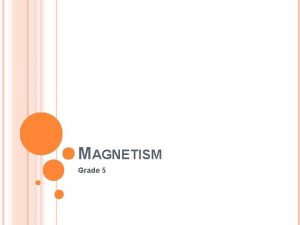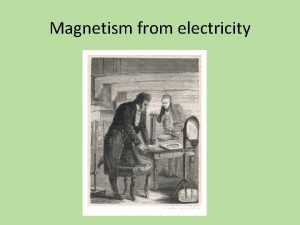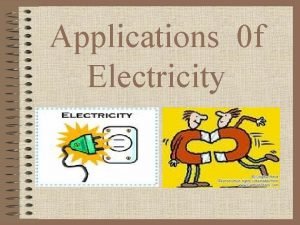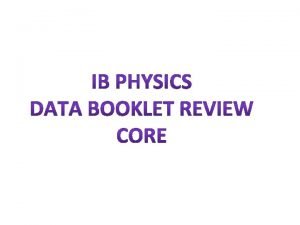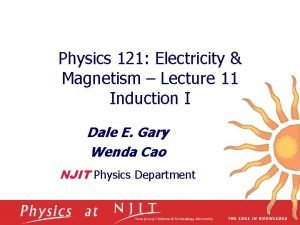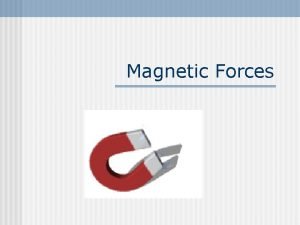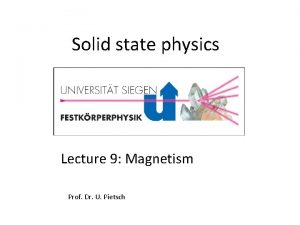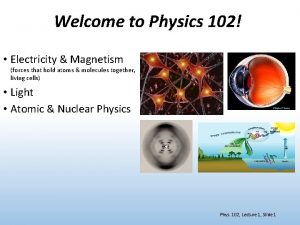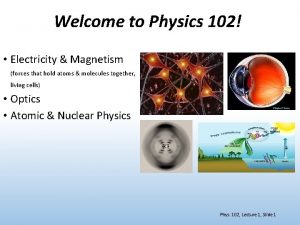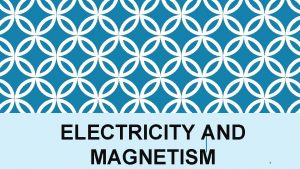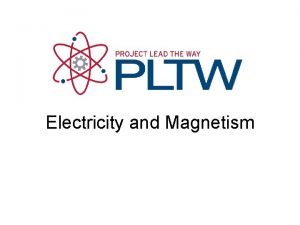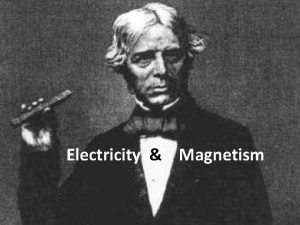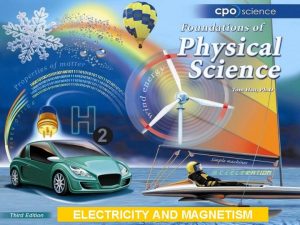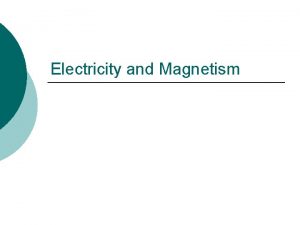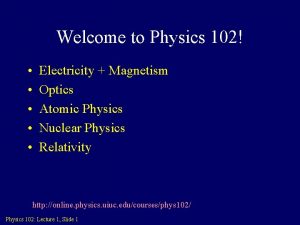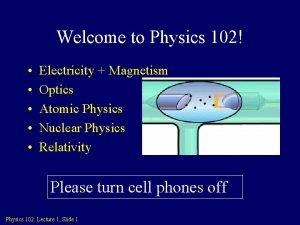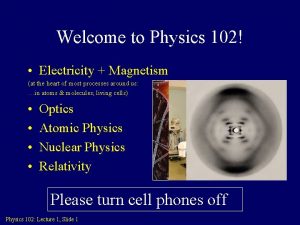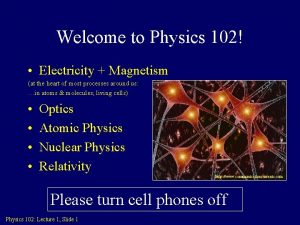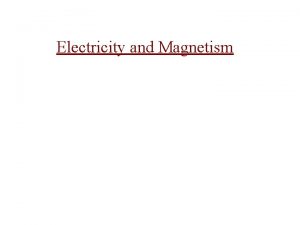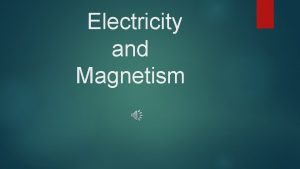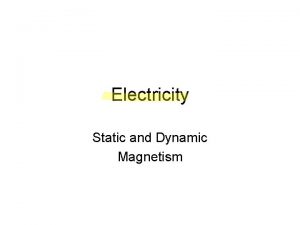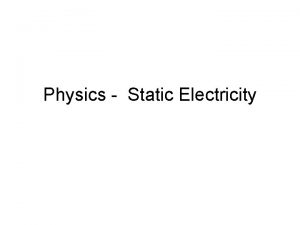Welcome to Physics 102 Electricity Magnetism forces that









![Units of electric charge • Symbol: q or Q • Unit: [Coulomb] = [C] Units of electric charge • Symbol: q or Q • Unit: [Coulomb] = [C]](https://slidetodoc.com/presentation_image/49226f91bc0270ee82f6b66cb3c268a8/image-10.jpg)











- Slides: 21

Welcome to Physics 102! • Electricity & Magnetism (forces that hold atoms & molecules together, living cells) • Light • Atomic & Nuclear Physics Phys. 102, Lecture 1, Slide 1

! e t i is u q e r re P Course content Physics 101 Physics 102 Macroscopic • • • Kinematics Forces Energy Fluids Waves (Sound) Microscopic • • Electricity & circuits Magnetism & induction Optics Modern Physics Phys. 102, Lecture 1, Slide 2

Meet the course directors • Lecturer: Research: Office Hours: • Discussion coordinator: • Lab & exam coordinator: Phys. 102, Lecture 1, Slide 3

When emailing me: • Email must be sent from @illinois. edu • Subject line should begin with “PHYS 102 question: ” • Message should contain: your full name, Net. ID, discussion section, TA name • Questions about physics: Do not use email, use office hours (see course website) • Before emailing: Verify information is not already on the course website The course directors reserve the right to penalize your HW score if you ask questions via email that are answered on the website Phys. 102, Lecture 1, Slide 4

Course Website • http: //courses. physics. illinois. edu/phys 102/ • Course Description / Excused Absences • First Discussion: • First Lab: • Exam dates: • Required Materials: Be sure to register your i>clicker prior to lecture Phys. 102, Lecture 1, Slide 5

Course Philosophy • Think about it (pre-lecture & checkpoint) • Untangle it (lectures) • Play with it (labs) • Challenge yourself (homework) • Close the loop (discussion/quiz) The order is important! Phys. 102, Lecture 1, Slide 6

Phys 102 – Lecture 1 Electric charge & Coulomb’s law Phys. 102, Lecture 1, Slide 7

4 Fundamental forces of Nature Phys. 101 Phys. 102 Gravitational force (solar system, galaxies) Electromagnetic force (atoms, molecules) Strong force (atomic nuclei) Weak force (radioactive decay) < Gravitational weakest < Weak < Electromagnetic Strong strongest Phys. 102, Lecture 1, Slide 8

Electric charge Charge is an intrinsic property of matter, like mass • EM force -> electric charge Positive & negative charge Opposite charges attract, like charges repel – • Gravity -> mass Mass always positive Gravity always attractive + + + – – DEMO Phys. 102, Lecture 1, Slide 9
![Units of electric charge Symbol q or Q Unit Coulomb C Units of electric charge • Symbol: q or Q • Unit: [Coulomb] = [C]](https://slidetodoc.com/presentation_image/49226f91bc0270ee82f6b66cb3c268a8/image-10.jpg)
Units of electric charge • Symbol: q or Q • Unit: [Coulomb] = [C] + Electron: –e = – 1. 6 x 10– 19 C Proton: +e = +1. 6 x 10– 19 C – • How much charge is 1 C? Imagine you could separate H+ and OH– ions in pure water (p. H 7. 0) H+ OH– H+ H+ OH– OH– H+ OH– Phys. 102, Lecture 1, Slide 10

Conductors & insulators Q: How do electrons behave in a perfect conductor? – – Q: How do electrons behave in a perfect insulator? – – – + – – – – + + – + – + Most things are in between perfect conductor / insulator Phys. 102, Lecture 1, Slide 11

ACT: Conductors Electrons are placed on a neutral conducting sphere. Which of the following diagrams correctly depicts how the charges are distributed? A. At the bottom B. Spread uniformly C. On the surface – – – – – – DEMO Phys. 102, Lecture 1, Slide 12

Conservation of charge Charges are physical entities (ex: electrons, protons) Cannot be created or destroyed + – The net charge in a closed system is conserved However, charges (often electrons) can be transferred from one object to another Phys. 102, Lecture 1, Slide 13

Demo: electroscope • Charging by conduction Charged rod is brought near scope Charged rod touches scope transferring some charge Scope is left with same charge as rod – – – Conducting sphere +– – – + + – – Insulating cage + – + + Gold leaves – Phys. 102, Lecture 1, Slide 14

Demo: electroscope • Charging by induction Charged rod is brought near scope (but does NOT touch) Scope is briefly grounded allowing charge to flow on (or off) Scope is left with opposite charge as rod – – – +– – + + – Ground wire – + + – – Phys. 102, Lecture 1, Slide 15

ACTs: Electroscope A positively charged rod is used to charge an electroscope by induction. What is the resulting net charge on the electroscope? A. positive B. zero C. negative If the conducting electroscope were replaced by an insulating ball and then charged by induction as above, what would be the net charge on the ball? A. positive B. zero C. negative Phys. 102, Lecture 1, Slide 16

Coulomb’s Law (1785) Force between charges q 1 and q 2 separated a distance r: itu n ag “Coulomb constant” de M Or: re Di io ct “Permittivity of free space” n Opposite charges attract, like charges repel Phys. 102, Lecture 1, Slide 17

Coulomb’s Law What is the magnitude of the force on the proton due to the electron in hydrogen? Proton qp = 1. 6 x 10– 19 C + – Electron qe = – 1. 6 x 10– 19 C r = 0. 53 x 10– 10 m Compare to gravitational force between them (Phys. 101) Phys. 102, Lecture 1, Slide 18

ACT: Coulomb’s Law What is the direction of the force on the proton due to the electron in the hydrogen atom? proton A. Left + – B. Right electron C. Zero What is the direction of the force on the electron due to the proton? Phys. 102, Lecture 1, Slide 19

ACT: Coulomb’s Law Two charges q 1 = +1 μC and q 2 = +10 μC are placed near each other. Which of the following diagrams correctly depicts the forces acting on the charges? A. B. C. q 1 = +1 μC q 2 = +10 μC

Summary of Today’s Lecture • Electric charge • Conservation of charge • Conductors and insulators • Coulomb’s Law for the force between charges Much more on Coulomb’s Law in next lecture Phys. 102, Lecture 1, Slide 21
 Physics 102 electricity and magnetism
Physics 102 electricity and magnetism Ib physics topic 5 questions
Ib physics topic 5 questions Magnetism
Magnetism Electricity jeopardy
Electricity jeopardy Sph3u electricity and magnetism
Sph3u electricity and magnetism Relationship between electricity and magnetism
Relationship between electricity and magnetism Electric susceptibility formula
Electric susceptibility formula Magnetism grade 5
Magnetism grade 5 Electricity and magnetism
Electricity and magnetism Electric fuse and circuit breaker graphic organizer
Electric fuse and circuit breaker graphic organizer Electricity and magnetism
Electricity and magnetism Electricity and magnetism
Electricity and magnetism Electricity and magnetism
Electricity and magnetism Magnetism vocabulary
Magnetism vocabulary N= what
N= what Static electricity and current electricity
Static electricity and current electricity Electricity n
Electricity n Magnetism in solid state physics
Magnetism in solid state physics Chapter 24 magnetism magnetic fundamentals answers
Chapter 24 magnetism magnetic fundamentals answers Ngoại tâm thu thất chùm đôi
Ngoại tâm thu thất chùm đôi Block xoang nhĩ ecg
Block xoang nhĩ ecg Thơ thất ngôn tứ tuyệt đường luật
Thơ thất ngôn tứ tuyệt đường luật







